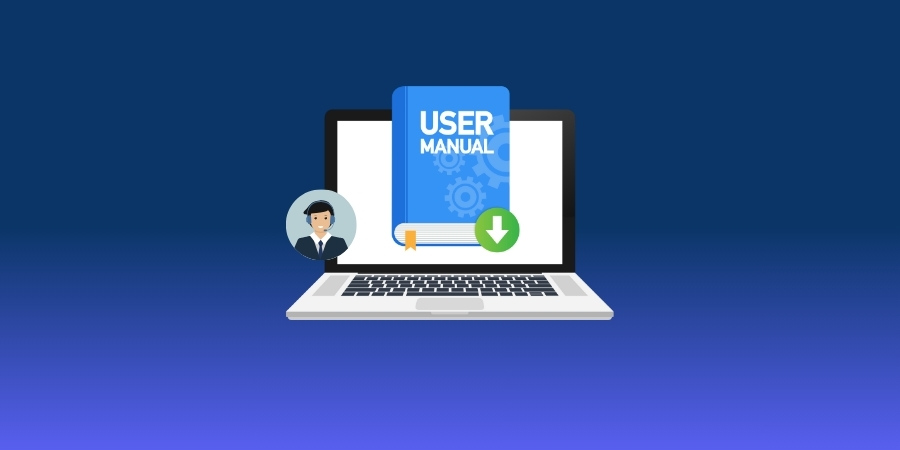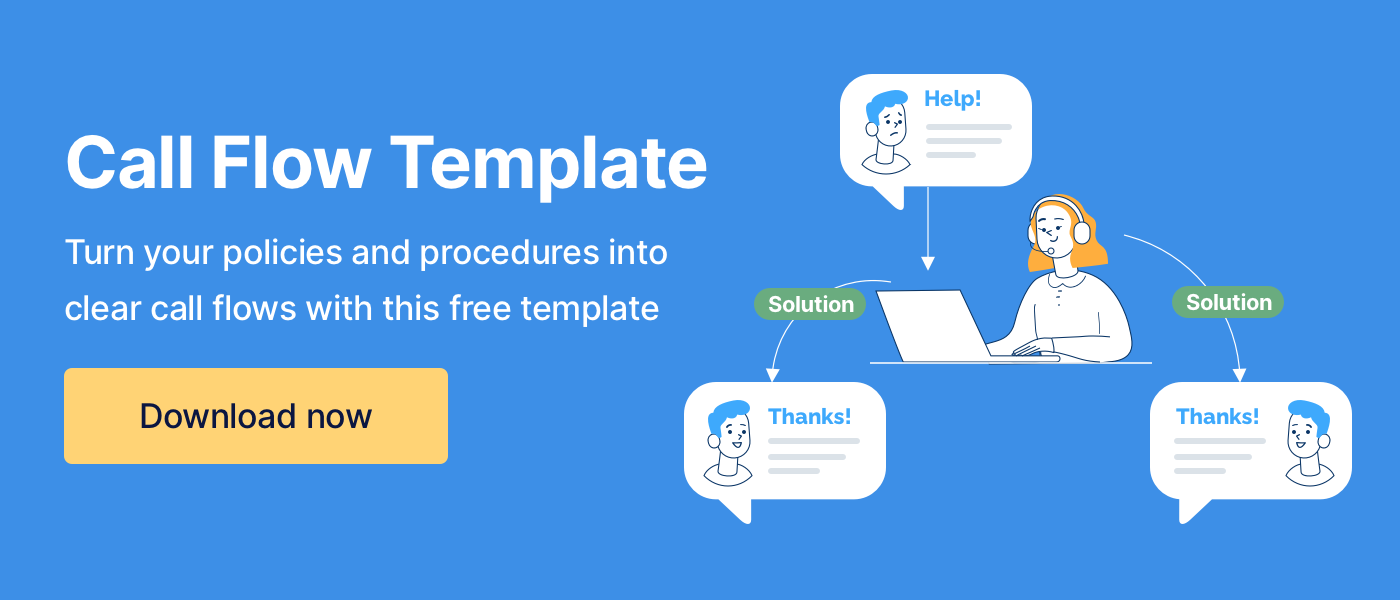5 Sections to Include in Your Call Center Training Manual
Writing a training manual for your call center is tough.
You have a plethora of knowledge and experience that you want to capture in your training manual. But, if you put too much information in one manual, then it will overwhelm your agents.
But too little information leaves agents lost and confused. So, what are you to do?
Essentially, we have a classic tale of Goldilocks and the Three Bears. You don’t want your instructions to be too advanced or too simple, but you want them to be just right so your employees can follow them.
 Image created via Canva AI
Image created via Canva AI
As a former journalist, I worked five years balancing the “just right” as I quickly decided how detailed to make my stories. (For every published news article, there are at least 3X the number of notes.)
I now use that knowledge as the Content Marketing Manager at ScreenSteps — a knowledge ops solution that helps call centers transfer knowledge faster — to help others balance providing too much and too little information.
If you want to curate a “just right” training manual for your call center, here are five sections to include in your training manual. Each section helps you identify essential information you should include in your training manual.
FREE DOWNLOADABLES
Need help capturing your call flows and procedures? If you are writing call flows and SOPs for your call center, download these free resources to help you get started:
1. Intake script
Every call center agent will need to use your intake script. It’s the most basic call center agent task. An intake script is a series of questions your agents ask customers when they call your company.
Depending on your company policies, you may want agents to follow a script verbatim or you may want agents to use a checklist. Agents are prompted by the checklist but then uses check off items from a list while using their own words to direct the call.
When someone calls into a call center, the agent has three things they need to discover using the intake script.
I. Lead the call with questions
When a call center agent lets the caller lead the call, it can take longer to get to the purpose of the call. That’s why we recommend having agents lead the call.
When an agent answers a call, they need to identify the purpose of the call. To figure out why the caller is reaching out, you’ll want to cover a lot of ground with as few questions as possible.
With an intake script, reps have a series of questions to ask. This order of operations helps get to the purpose of the call quicker. These questions are used to identify the caller, understand the purpose of the call, and then either transfer (or continue the call with the same agent) the caller to resolve the issue.
Explain the purpose of these questions in your manual and then provide questions — including the order they should be asked in — as part of your intake script. This helps agents avoid making mistakes.
II. Gather information
Through this series of questions, your agents can gather information about the caller and the purpose of the call.
If you gather this information upfront, then the caller won’t need to repeat as much information as they are transferred or get their call resolved.
The information you are gathering during your intake includes:
- Name of person calling
- Account number
- Number to call if disconnected
- Verification questions
III. Identify the purpose of the call
As you know, not every caller gets to the point quickly (or even knows how to state the point of their call). Your reps need to be skilled at discerning the purpose of a call. Your reps need to help the caller articulate what’s going on/what they need help with.
Once they know the purpose of the call, your reps can either handle the call (using the sections outlined below) or transfer the call to someone else.
At this point, they will use a call flow and procedure, which should also be included in your manual. The procedures will help resolve the call.
2. Tips for improving soft skills
Part of being a good call center agent is having strong interpersonal skills. People will phone your call center for a variety of different reasons. You need to train agents on soft skills to make the call a good experience for your caller.
These soft skills are all about helping call center agents act naturally and sound like themselves on calls. Some of those soft skills include:
Responding with empathy
Often, when callers reach out to your customer support team, it’s because something has gone wrong. These callers can be frustrated and irritated that they need to take time out of their crazy day. (And then they were on hold for an hour. Ugh!)
Teach agents how to express empathy in your training manual. Provide tips and phases that can be their go-to in case a caller complains. Sometimes all a caller needs to hear is your reps to acknowledge the inconvenience (without admitting fault).
For example, “I’m sorry you’ve been on hold for so long. Let’s see what I can do for you so that we can get you back to your day as quickly as possible.”
De-escalating situations
Remember when I said people aren’t always at their best when they call into a call center?
Sometimes these situations can escalate to the point that callers are yell and us words that aren’t meant to be repeated. That’s not a fun situation for your call center agents, but they still need to be prepared for it.
Prepare your agents by helping your agents understand these callers’ situations and states of mind. In your training manual, teach them the steps to de-escalating situations.
Write out your policy on what they can do. What offers can they provide? Or who do they need to turn to for those offers? At what point are they allowed to hang up on a caller?
 Sounding conversational
Sounding conversational
Even if you aren’t having agents follow a script verbatim, there is always the chance that your agents could sound robotic.
In fact, that’s probably what you want to avoid, which is one of the reasons why you are using real human beings in your call center instead of an automated messaging system.
Include tips in your training guide on how to stay professional while conversing with the caller. This could include suggestions like responding to things the caller says or asking personal interest questions while you complete processing the caller’s request.
🔍 Related: How to Make Call Center Training Less Stressful For Your Agents (4 Tips)
3. Call flows
A call flow is a guide your reps would use during a call. It’s a road map that includes details on how to handle specific situations and transactions. The call flows should include prompts for what to say, what to do, and what questions to ask.
While procedures are detailed information for specific processes, a call flow is more of a guide to help the rep determine which procedure needs to take place to resolve the call.
A call flow has the bare minimum information so that the rep can easily reference it during a call without getting bogged down with details and quickly narrow down the caller’s needs. The call flows will reference procedures, such as “how to record a complaint.” Then the call flows can direct agents to specific procedures for detailed assistance.
In a manual, create separate call flows for specific inquiries. For example, “How do I get my invoices for billing” could be one call flow and, “How do I update my billing information?” would be a different call flow.
A call flow takes you to the correct procedure and helps you determine what needs to be accomplished to resolve this call.
4. Procedures
Once your agents discover the purpose of a customer's call, then they will need specific procedures. The procedures provide step-by-step instructions on how to handle different inquiries and situations.
Use the procedures to help agents know where to click in your system to accomplish a process. For example, here’s how you would refund a purchase, fill out an order, record a complaint, etc. in our system.
Procedures should include both written explanations and visual aids to help agents feel confident in performing tasks.
Warning: In your training manual, this is where you have to be extra cautious about including too much or too little information.
It helps to write your manual so that it is easy to see the important next steps. This could be:
- Bolding
- Using different colors
- Indenting
- Something else that helps the vital information pop
For new hires or less experienced agents, you can include more detailed information, but you’ll want to make it easy for employees who don’t need the extra help to skim through or skip entirely.
SOP DOCUMENTATION TIPS
Documenting standard operating procedures (SOPs) for your call center? Download this free SOP template packet. Get additional tips on writing SOPs here and see SOP examples here.
5. Troubleshooting guides
What are some common (and less common) issues your callers need help resolving?
Customers frequently call in when they need help troubleshooting an issue. Your call center agents need to be able to walk a caller through a troubleshooting process in detail.
Have an entire section dedicated to walking agents through your troubleshooting steps for specific transactions. Some of these troubleshooting scenarios could include:
- Error code 201
- Machine is smoking
- Product won’t turn on
As your call center agents follow these troubleshooting guides in your manual, they need to know the order to try solutions.
When a customer calls an internet company’s customer service team about their internet not working, the first step is always to restart the router. If that doesn’t work, the agent moves onto the next resolution step.
By breaking these steps down, you're providing your agents with a guide that is easy to look up and follow in your training manual.
Each section helps you identify essential information you should include in your training manual.
Help call center agents handle calls confidently & independently
Now you know some vital tasks to include in your training manual. You need help guides that will assist your agents throughout all stages of a call.
That means your call flows and SOPs need to be easy to find, easy to follow, and easy to scan while your agents are on a call.
With ScreenSteps, you can create step-by-step call flows that guide an agent through a call. Your agents won't even need to put the caller on hold. They'll be able to find what they need in just a few clicks. Plus, they'll be able to quickly follow the workflows while holding a conversation with the customer.
But the first step is, of course, documenting your call flows and procedures that will go in your call center training manual.
Download our free call flow template to get started.
Learn more about how ScreenSteps can help your call center transfer knowledge more efficiently here.




